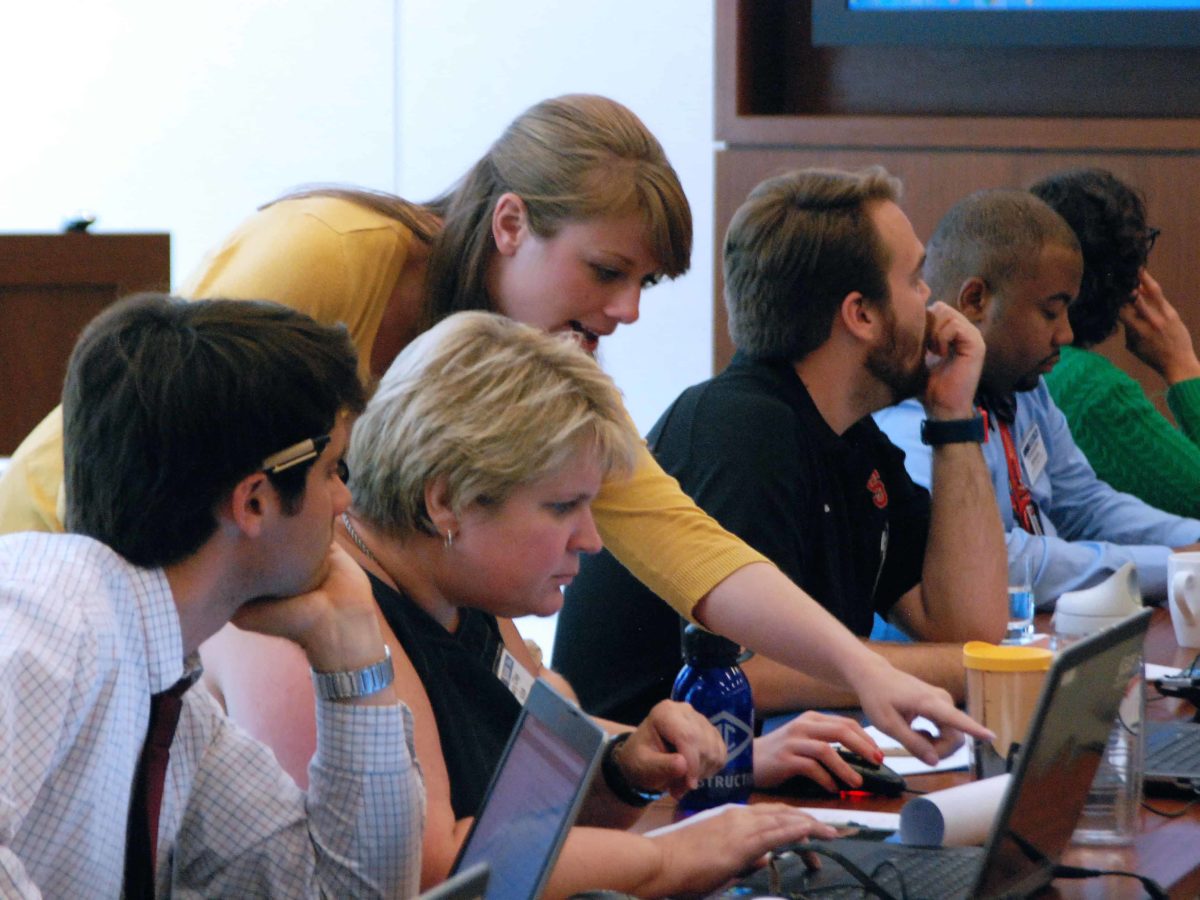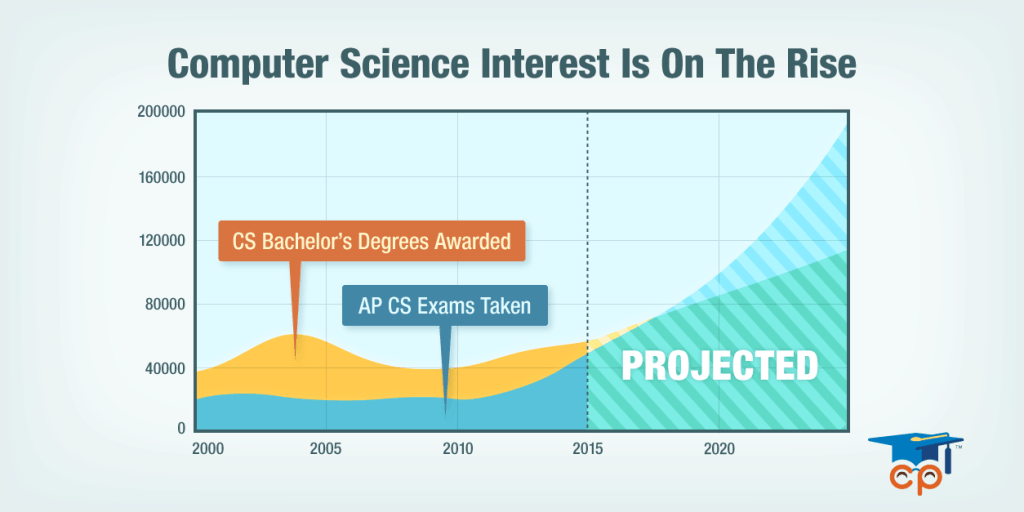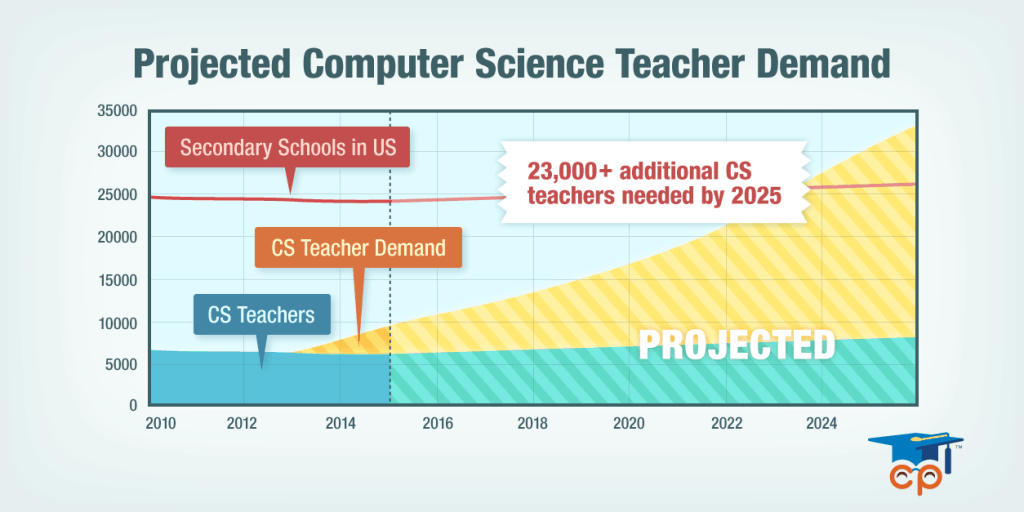
“In the coming years, we should build on that progress…offering every student the hands-on computer science and math classes that make them job-ready on day one.”
—President Barack Obama, State of the Union Address, January 2016
Due in large part to Code.org’s advocacy campaign and their remarkable Hour of Code event, support for K-12 computer science education has grown tremendously. Localized, grassroots efforts have transformed into a national campaign to ensure all students have equitable access to computer science courses at school–and by computer science, we mean programming, robotics, computational thinking skills, etc. as opposed to computer fluency concepts like keyboarding and business applications. Can you hear the CS education enthusiasts cheering? However, such momentum begs the question: but who’s going to teach it? Let’s start with the good news.
Relevant Changes in Computer Science Education Policy
While a lot of educational leaders in this country are chatting about computer science (including the President during the 2016 State of the Union Address), the most compelling evidence of this movement is in policy reform.
- Computer science listed as a core academic subject. A crowning achievement for the computer science education world came in December 2015 with the reauthorization of the Elementary and Secondary Education (ESEA) reauthorization, now known as the Every Student Succeeds Act (ESSA), which listed computer science as a core academic subject alongside English language arts, mathematics, science, social studies, etc. Moreover, twenty-eight states plus DC now allow CS courses to count toward graduation (as of 2/3/16).
- Increased funding. In the wake of the ESSA, the White House announced the CS For All (#CSforAll) initiative this past weekend (January 30). The initiative hopes to “empower all American students from kindergarten through high school to learn computer science…to be creators in the digital economy, no just consumers.” The initiative also calls for “$4 billion in funding for states and $100 million directly for school districts” to expand K-12 CS professional development and teaching materials. This funding builds on additional opportunities (e.g., National Science Foundation) announced late last year for professional development and support for science, technology, engineering, and math (STEM), which includes computer science.
- Computer science as a required offering (read: computer science in every school). In 2015 Arkansas passed legislation that requires all secondary schools to offer computer science by 2015-2016. The Natural State now joins Texas with this requirement. New York City, Chicago Public Schools, and San Francisco schools have made a similar promise, following the example set by Broward County, FL, and Charles County, MD. Other states, such as Florida, are predicted to follow suit in the coming years.
- Computer science required for graduation. Chicago Public Schools announced last year that computer science will be a required graduation credit. In other words, all students must take computer science in order to graduate from high school.
If the past 24 months is any indication of the future, we can expect to see several more states and districts adopting similar policies to broaden participation in computer science—a welcome effect for many. In a recent study, approximately 91% of parents agreed they want their children to learn computer science; and more than half of parents, teachers, principals, and administrators feel learning CS is just as important as learning subjects such as math, English, science, and history. However, many students, especially minority students, do not have access to computer science courses. With additional federal funding, states and districts can remedy that problem. Along with the demand from educational stakeholders, it’s reasonable to predict a dramatic shift in the CS landscape over the next 10 years.
Let’s start by taking a look at the number of students that have taken (and are predicted to take) the AP Computer Science A exam and the number of college graduates who have received (or are predicted to receive) a bachelor’s degree in CS from 2000 to 2025. We’ve seen a couple of spikes in CS graduates over the past 50 years—and the data suggests we’re on the verge of another one. Not only that, but the number of students taking AP Computer Science is on the rise as well. We used trendlines based on data from 2000 to today to predict growth in both AP CS enrollment and CS graduates, and the results are telling. We should also note that, this fall, the College Board is scheduled to launch a new, more accessible AP course, AP Computer Science Principles; therefore, our predictions are likely quite conservative.

Existing Resources
While these policies might be recent news, the need and motivation for computer science education is not. Because CS is vital to many companies today, the need for skilled computer scientists is growing rapidly. As a result, a lot of large companies and organizations, like SAS, have been philanthropically supporting K-12 CS instruction for years—especially since 2013, following the popularity of the Hour of Code.
While the tech industry is known for many things, agreeing among themselves on big issues is not one of them. Except for this one. Apple, Google, Microsoft, Facebook, Amazon, SAS and so many others compete vigorously for talent, ideas and market share, and yet they have come together to support broadening access to computer science education. I’m proud of my colleagues and humbled by their trust on this important issue and hope that the tremendous success of the Hour of Code is only a sign of good things ahead.
—Hadi Partovi, Co-founder and CEO, Code.org. Testimony before Congress 1/9/14
Resulting from students’ and teachers’ desire to go beyond an hour, CSEd is now rich in free, comprehensive instructional resources (e.g., Code.org, Exploring Computer Science). Such support is expected to increase as the Framework for K-12 CS Education project continues to make headway this year. In fact, as we mentioned above, the effect has bubbled all the way up to the College Board.
In sum, we computer science education enthusiasts now have the nod from state and federal government—which means more support, more money, and more justification for CS courses—and a great start on creating curricular resources to get these courses off the ground. Excellent news for computer science.
But who’s going to teach it?
The Demand for CS Teachers
By coupling predicted implications from existing and pending federal, state, and district-level policies with various data sources (AP Computer Science enrollment, current CS course offerings, U.S. educational institution projections, U.S. teacher projections), our trendlines predict a significant demand for computer science teachers over the next 10 years. Right now, just one in four schools teach CS programming courses, only 21 states provide pathways for teacher credentialing in CS, and many states do not require a CS teaching credential to teach computer science.
Here’s the harsh reality: very few teachers have official CS credentials. Of the 206,059 public school teachers in New York, for example, only 2,271 have the Computer Studies teaching certification. That’s 1.1%.
Based on the data and facts we’ve already presented, we know that statistic is bound to change. In fact, we’re predicting that by 2025, CS will be taught in the majority of schools and that one-sixth of all secondary teachers will be called on to teach computer science—a fair prediction considering CS is now listed as a core academic subject. Using these numbers, we expect that the United States will need more than 30,000 secondary teachers qualified to teach CS by 2025. On the other hand, if CS training for teachers stays the same as it is now, we could expect a shortage of more than 23,000 teachers.

Four Existing Professional Development Models
School officials, state leaders, and other organizations are already well aware of the looming CS teacher shortage, with many groups providing low-cost and free options for professional development. Preparing educators to teach this up-and-coming discipline is complicated because of the many competing factors including formalized teaching credentials, the ever-changing landscape, teacher turnover, and much more. Below we’ve outlined the most promising potential solutions for closing this gap; however, each comes with a viable counter-argument.
Potential Solution 1: Develop online PD courses that can be widely distributed at a nominal cost (e.g., Microsoft’s TEALS program).
Counter-argument: Many feel this is a stop-gap effort due to the high rate of teacher turnover, especially in the STEM fields. Statistics suggest teachers appointed to go through such programs are likely to change schools or occupations within 5 years; thus, continuously training new teachers does not promote a culture of CS education compared to established disciplines that are more resistant to the effects of teacher turnover. For more details, read The Revolving Door: Computer Science for All and the Challenge of Teacher Retention.
Potential Solution 2: Develop online, virtual courses for students taught by established CS educators that can be widely distributed across the country.
Counter-argument: As seen in other disciplines, computer science instruction benefits greatly from just-in-time, personalized feedback. Fielding specific student questions, troubleshooting programming bugs, and other classroom dynamics demand the need for in-person support. Read more: “Seeing Myself Through Someone Else’s Eyes:” The Value of In-Classroom Coaching for Supporting Exploring Computer Science Teaching and Learning.
Potential Solution 3: Instruction provided by local CS professionals or CS graduates.
Counter-argument: In order to deliver effective instruction, educators need “in-depth computer science knowledge as well as strong pedagogical content knowledge, developed through a computer science methods course.” In other words, there is a lot more to teaching than just knowing the content. Read more: Learning to Teach Computer Science: The Need for a Methods Course.
Potential Solution 4: Develop College of Education pre-service programs following a consistent curriculum model such as one that includes traditional education and CS courses, field experience, and industry mentorships (e.g., see A Curriculum Model for Preparing K-12 Computer Science Teachers; Georgia Tech’s methods course).
Counter-argument: Although CS teaching programs currently exist (e.g., Purdue, Georgia Tech), they currently suffer from under-enrollment. Is it a lack of undergraduate’s interest or confidence in computer science, and is this due to a lack of exposure to CS in K12? Or is it the appeal of job opportunities and generous salaries waiting for those who do CS rather than teach it? Probably both.
As the CS education world continues to work out the best course of action, we should mention some additional good news. As part of listing CS as a core subject through the ESEA reauthorization and ESSA, states can finally make a justifiable case for allocating funds specifically for CS professional development programs. We’re already seeing a surge in the number of states creating pathways to CS teaching certification (currently 21)—a “bug” in the CS education system for quite a while. As such programs are created, experts like the Computer Science Teachers Association warn that states should communicate and strive for consistency.
For more on the progress, challenges, and open research questions related to computer science education, check out Dr. Mark Guzdial’s Computing Education Blog and proceedings from ACM’s Special Interest Group on Computer Science Education (or attend their conference this March in Memphis, TN; see you there!).
This article originally appeared on the SAS Curriculum Pathways & Instructional Technology’s Pathfinder blog on February 4. It is reprinted here with the author’s permission.
Recommended reading


